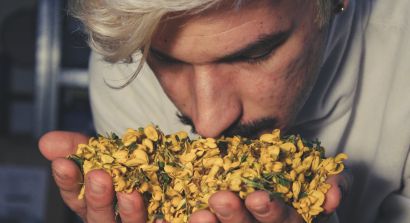- About
- Organization
- Organization Overview
- Dean’s Office
- Department of Bioengineering and Therapeutic Sciences
- Department of Clinical Pharmacy
- Department of Pharmaceutical Chemistry
- Quantitative Biosciences Institute
- Org Chart
- Research
- Education
- Patient Care
- People
- News
- Events
Making sense of scents
By Levi Gadye / Mon Mar 20, 2023

Unsplash/Creative Commons
The human body is neurologically wired to sense the physical world. Cone cells in the retina detect specific wavelengths of light, while cells in the inner ear detect specific frequencies of sound, giving the brain a rich palette of sights and sounds to paint the human experience.
UCSF scientists have shown for the first time how an odorant, or smell molecule, activates a particular olfactory receptor7, breaking a longstanding impasse in understanding olfaction—our connection to the world of scent.
The findings, which were published on March 15 in Nature, are poised to reignite interest in the science of olfaction with implications for food science, fragrances, and beyond. They also open the door to a deeper understanding of olfactory receptors, which constitute half of all G-protein coupled receptors, a class of proteins critical for a range of biological functions well beyond our senses.
“We’ve dreamed of tackling this problem for years,” said Aashish Manglik, MD, PhD, lead author on the study and faculty member in the UCSF School of Pharmacy’s Department of Pharmaceutical Chemistry. “We now have our first toehold, the first glimpse of how the molecules of smell bind to our odorant receptors. For us, this is just the beginning.”
Explore how Manglik and his colleagues made this breakthrough in olfactory science on UCSF News8, featuring an interactive 3D model of an olfactory receptor bound to the odor molecule, propionate, which contributes to the smell of Swiss cheese.
Tags
Category:
Sites:
School of Pharmacy, Department of Pharmaceutical Chemistry, PharmD Degree Program
About the School: The UCSF School of Pharmacy aims to solve the most pressing health care problems and strives to ensure that each patient receives the safest, most effective treatments. Our discoveries seed the development of novel therapies, and our researchers consistently lead the nation in NIH funding. The School’s doctor of pharmacy (PharmD) degree program, with its unique emphasis on scientific thinking, prepares students to be critical thinkers and leaders in their field.




